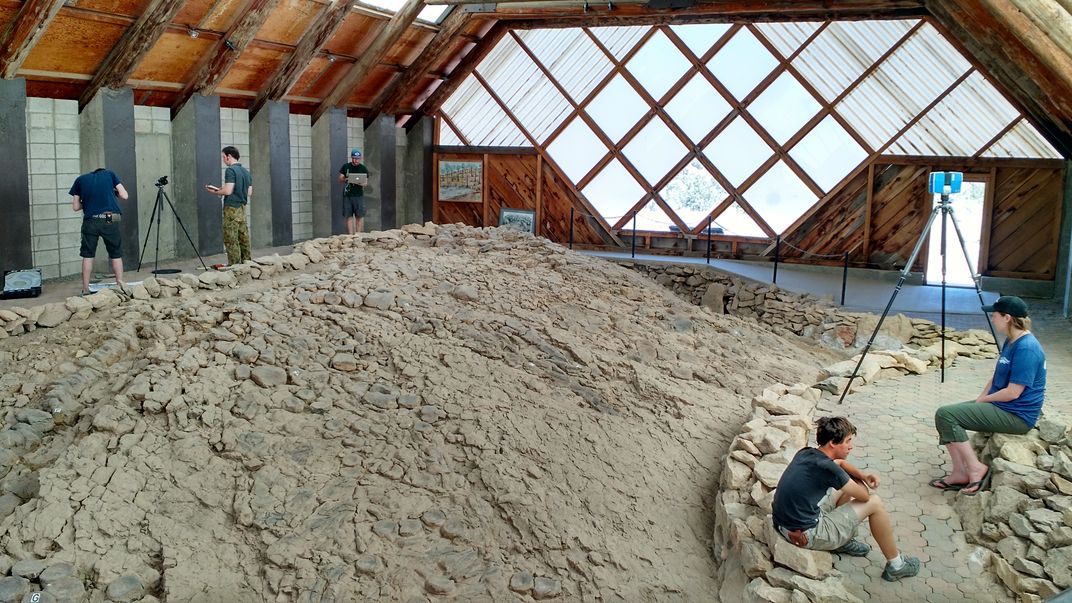What Killed These Marine Reptiles Found in a Nevada Ghost Town?
Paleontologists are going high tech to solve the mystery of a mass ichthyosaur death near the old mining town of Berlin
/https://tf-cmsv2-smithsonianmag-media.s3.amazonaws.com/filer/aa/4f/aa4f1698-643e-476e-a61b-b748ef487026/ichthyosaur.jpg)
Nestled near an abandoned mining town in the heart of Nevada, Berlin-Ichthyosaur State Park may be the loneliest fossil monument in America.
“The park is about a three-hour drive from Reno,” says paleontologist Neil Kelley of Smithsonian's National Museum of Natural History. After you pass through the small town of Fallon, “you can easily drive the remaining two hours without seeing another vehicle.”
But there’s something very special about this isolated spot that has drawn a multi-institution team of paleontologists into the Nevada desert: The park houses a 217-million-year-old murder mystery.
The park’s name comes in part from a massive bone bed that has puzzled scientists since its discovery in 1928. Excavations in the 1950s and '60s by University of California, Berkeley paleontologists Charles Camp and Samuel Welles revealed that the site boasts nearly 40 individuals of one of the largest marine reptiles of all time.
These ichthyosaurs, named Shonisaurus popularis by Camp, could reach 49 feet in length, and the paleontologists undertaking the original excavations suspected that the dense accumulation was a mass stranding similar to what happens to whales today.
But continuing work at the site didn’t support Camp’s idea. The preservation of the bodies and the details of the rock they were found in showed that they had been deposited in deep water, not on the shore, so something else must have happened to the ichthyosaurs.
Some sort of deadly algae bloom seemed like a good candidate. And more recently, one researcher jumped into the deep end of speculation to suggest the ichthyosaurs had been killed by an enormous squid, which carefully arranged the bones in its lair.
All the while, the true story of what happened has remained in the rock.
Now Kelley and colleagues are taking another crack at the site. The inspiration for this new effort came from recent work by Kelley's fellow Smithsonian scientist and collaborator Nick Pyenson. During the widening of the Pan-American Highway from 2010 to 2012, workers uncovered a mass death assemblage of marine mammals in Cerro Ballena, Chile. Pyenson, a fossil whale expert, quickly alerted the Smithsonian's 3D Digitization team, who rushed to Chile and used laser scans and photographs to digitally document and preserve the discovery.

The researchers thought the same techniques could easily be applied to the Berlin-Ichthyosaur site, Kelley says, especially since the boneyard is a permanent public display left where it was found in the Nevada mountainside. This is where new tech meets very old bones.
“We have adopted a multi-platform digitization approach, using medium-range laser scanning, LiDAR, structured light scanning and photogrammetry to digitize the site at multiple scales,” Kelley says.
The result is a high-resolution digital version of the bone bed that provides a pterosaur’s-eye-view of the whole site, as well as detailed scans of the individual bones. This will not only provide key information about the fossils, but will also eventually allow people all over the world to virtually explore the bone bed through publicly released digital models.
More than that, the paleontologists have also been scouting the surrounding area for additional fossils and geologic samples that may help explain the special circumstances within the quarry. As yet, the team is still poring over the maps and samples.
“We have some good preliminary clues and ideas” to what happened to the ichthyosaurs, Kelley says, “but we are still actively debating and discussing this and still investigating the data.”
The Shonisaurus die-off wasn’t the first of its kind, nor will it be the last, so figuring out what happened to the marine reptiles might do much more than help scientists piece together conditions in the late Triassic.
“We think that understanding the history of these events in deep time can help inform our understanding of current and future mass mortality events in marine ecosystems, and vice versa,” Kelley says.
Editor's Note: The photo credit for the Berlin-Ichthyosaur bone bed has been corrected.
/https://tf-cmsv2-smithsonianmag-media.s3.amazonaws.com/accounts/headshot/RileyBlack.png)
/https://tf-cmsv2-smithsonianmag-media.s3.amazonaws.com/accounts/headshot/RileyBlack.png)